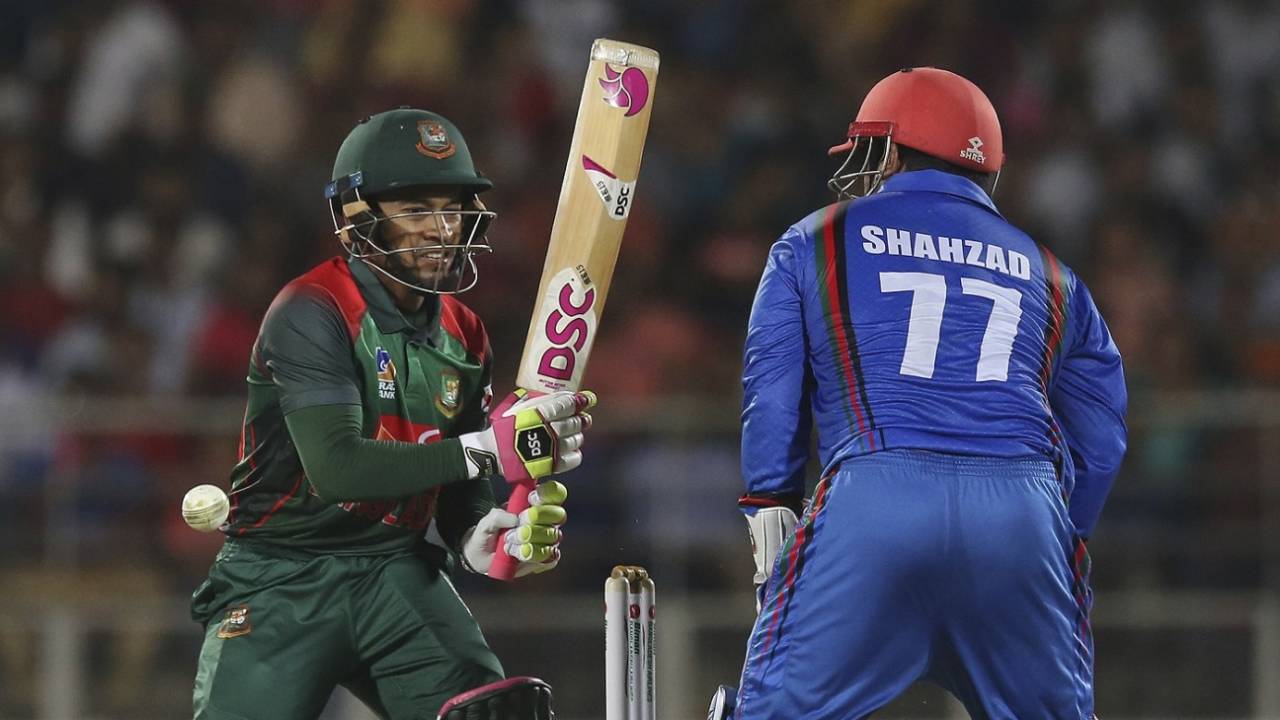Whitewash exposes Bangladesh's T20 failings
Familiar failings held the team back once again, chiefly the lack of big hitters and the failure of talented longer-format players to adapt to T20
Mohammad Isam
08-Jun-2018
Associated Press
"We will [next] be playing T20s almost 50 days from now, so by the time we play our next T20, everyone will forget about it."
As an extremely busy professional cricketer, Shakib Al Hasan has sometimes been accused of being disconnected from Bangladesh's everyday reality. But with this statement, which he made after Bangladesh's one-run loss to Afghanistan on Thursday night, Shakib showed he is perfectly in tune with the pulse of the cricket-mad nation.
He knows all too well that a win in the West Indies in the Tests or ODIs next month will push the Afghanistan nightmare in Dehradun into the distant past. Every big loss is forgiven and forgotten in the minimal-attention-span world of Bangladesh cricket. It makes post-match analysis, debriefings and accountability almost non-existent.
While Shakib suggested that the fans forget quickly, the statement rang true for his teammates and bosses too. The shift from one extreme to the other is a chronic problem in the Bangladesh cricket team where the players know by heart that winning a match forgives every mistake and winning a bilateral series is the jackpot.
While a potential jackpot is still weeks away, the T20s against Afghanistan have given enough proof that while Bangladesh may be good at ODIs and progressing at home in Tests, they are nowhere in T20. They are the least improving cricket team in this format. Only Nazmul Islam, the left-arm spinner, has been picked exclusively for his domestic T20 performances, and he has slowly caught up to the demands of T20 internationals too.
But someone like Mehidy Hasan, who burst on to the Test arena in 2016, hasn't found ways to adapt his lines, lengths and trajectories to adapt to T20. He is picked mainly because he is a talented bowler and is expected to become a more mature all-round cricketer. He doesn't possess, at least so far, any real T20 attributes. In the spin department, Bangladesh were crushed by Afghanistan's trio of Rashid Khan, Mohammad Nabi and Mujeeb Ur Rahman.
The Mehidy-Nazmul example is instructive of where Bangladesh stand overall in their understanding of T20, with ball and bat. Bangladesh's top seven in this series featured the best batsmen in the country, but not necessarily the best T20 batsmen. The ability to find the boundary regularly isn't evenly distributed across the line-up. Which is why the pattern of the third match in Dehradun was typical: Mushfiqur Rahim picked Karim Janat apart clinically to pick up five successive fours in the 19th over, but once he departed, Bangladesh couldn't find a way to score eight runs off the last over.
Mahmudullah is the team's designated hitter and while he has credibly turned himself into an efficient finisher, it is not his original job. He transformed himself into a big hitter only in 2016, and the lack of other similar players around him means he has to be the team's Carlos Brathwaite or Dinesh Karthik on a regular basis.

Associated Press
This is where the comparison with Afghanistan comes to the fore. Afghanistan's big hitting starts at the top with Mohammad Shahzad, and by the time the likes of Mohammad Nabi, Samiullah Shenwari, Najibullah Zadran, Shafiqullah and Rashid Khan come to the crease, regular six-hitting is almost guaranteed. It is a line-up that can, and often does, turn a modest 15-over score into a competitive 20-over total.
Bangladesh doesn't have that luxury. They only have Mahmudullah and, if he is set, Mushfiqur. Sabbir Rahman and Soumya Sarkar are at best good-looking batsmen who will make the odd half-century, but their overall stagnation as cricketers has meant they can't be relied upon to be consistent, certainly not in the last five overs.
Shakib admitted that it wasn't just end-overs batting that hurt his side in the third T20 but other factors too, including two run-outs in the same over.
"Even against the best bowler in the world, you'd expect two set batsmen to score nine runs off the last over," Shakib said. "But it doesn't mean we lost because of the last over. There are many reasons. We lost the match in many small phases.
"Our fifth bowler ended up giving more than 50 runs, which affected us. We had two run outs, which created the biggest difference in this game. There are many more."
Hopefully, Shakib will address these issues after the short Eid break next week, as Bangladesh prepare for the West Indies tour. There is enough time for a fresh start, and a new coach is already in place. Steve Rhodes is a reputed figure in English cricket whose energy and fresh eyes can only help the Bangladesh team.
But beyond all that, the players will themselves have to put in the effort to build their T20 skills and know-how. They cannot continue to forget and forgive inconsistent bowling, sluggish batting and poor body language. They can perhaps take a leaf from Mahmudullah's book, and understand how he transformed himself into a genuine hitter, and also learn from Nazmul how he has carved a niche for himself as a T20 bowler.
Mohammad Isam is ESPNcricinfo's Bangladesh correspondent. @isam84
